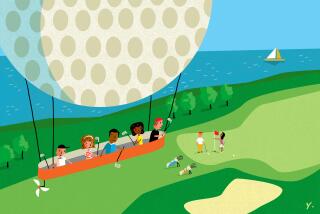A Secret Playground No More : After 51 Years, a Major Pro Golf Tournament Returns to Wilshire Country Club This Week
- Share via
Playing Wilshire Country Club for the first time, Ben Hogan arrived at the ninth tee, where a large mound on the fairway obscures the green. The usual way to play the blind tee shot was to aim for the white Hollywood sign, far up in the hills.
So when Hogan asked where he should hit his drive, his caddie told him to aim for the Hollywood sign.
“Which letter?” Hogan asked.
As it turns out, Wilshire always has been able to spell something special out there with its tree-lined fairways, the watery barranca and greens so true they know their lines well enough to win an Academy Award for putting.
Wilshire has been one of the city’s best-kept secrets, largely a playground for businessmen in stately Hancock Park. But the members are just about ready to open the gates and allow the curious an interesting peek at one of the city’s most venerable private courses.
This week, for the first time in 51 years, a major professional tournament will be played on the exclusive layout. That would be the $800,000 Ralph’s Senior Classic at Wilshire, where in 1944 Harold (Jug) McSpaden won the Los Angeles Open.
McSpaden, 87, who lives in Kansas City, Kan., said he was sort of nervous the first time he played Wilshire.
“I stood on the first tee and knocked my ball over the trees onto the 16th fairway,” he said.
McSpaden was sharp enough in 1944, though, to shoot 66 on the last day. He parred the 18th by two-putting from 60 feet, the first putt stopping a foot from the hole.
Bing Crosby and Bob Hope were in McSpaden’s gallery. “I remember Bing said ‘Look at that ball roll,’ ” McSpaden said.
On the fairways, the ball doesn’t roll as far anymore, since they have been irrigated for decades now.But the stories about Wilshire go on and on.
Dave Stockton, the leading money winner on the Senior PGA Tour, hopes he doesn’t play Wilshire the way he did the last time he tried it, in 1963 when he was at USC.
“I couldn’t keep it out of the trees,” Stockton said.
Funny, but that’s where Johnny Weissmuller’s putter landed one day after he hadmissed a short putt.
Since Weissmuller, an Olympic swimmer, had gone on to movie fame as Tarzan, his partners suggested he just climb the tree and retrieve the putter. Tarzan sent his caddie instead.
Wilshire was designed by Norman Macbeth on land acquired in 1858 by Henry Hancock, a surveyor and Mexican War veteran. The acreage was once part of a Mexican land grant known as Rancho La Brea.
There were oil derricks on the land when Macbeth spent several Saturday afternoons driving stakes in the ground, accompanied by his Airedale and occasionally by his son, Norman Jr.
Beverly Boulevard bisects the course, which is, generally, bordered by Melrose, Rossmore and Highland avenues and Third street. A narrow tunnel beneath Beverly, just wide enough for a golf cart, connects the layout.
The course opened in 1920 and even though you could see the Hollywood sign from the ninth tee, you didn’t see many actors. They weren’t particularly welcome, although Hope, Harold Lloyd, Leon Errol and Donald O’Connor later held memberships.
So did Howard Hughes, who was a talented golfer and Wilshire member long before he became a recluse. He even lived for a while in the white, stucco house that overlooks the eighth green.
According to legend, Jean Harlow sometimes appeared on the balcony in a negligee when Hughes’ group approached to the green. That distraction resulted in many a four-putt.
Hughes joined Wilshire in 1921, but did not play golf or visited there the last 40 years of his life.
Still, the Hughes legacy endures. There is evidence of it at every tee box, where the markers are painted drill bits, donated by two-time club champion Ditch Schaeffer and two other Wilshire members who worked for Hughes Tool Co.
Bob McKinnon, a Wilshire member who is on the greens committee for the Ralph’s tournament, said those drill bits are hard.
“I’ve seen guys hit a bad shot, get mad and take their driver and bust it on one of the drill bits,” McKinnon said. “The pro shop just sells them another club.”
Assuming all golf clubs remain intact, senior golfers may discover a pretty, if not undaunting track.
There are only three par-five holes on the 6,531-yard, par-71 course, but smallish, sloping greens, fairways that are generally narrow and the serpentine barranca that affects play on 13 holes are all capable of instilling elements of fear.
“Some long hitters might well reach some of the par-fives in two, but they still will be left with difficult shots to small, well bunkered greens,” said head pro Tom Rielly.
The barranca protects many of the greens, too. The water in the barranca originates at the Hollywood Reservoir, but it includes runoff from the Hollywood area and from underground springs.
More than 30 bridges span the barranca, all over the course. The last time there were so many bridges in one place, somebody wrote a book about it in Madison County.
McSpaden said Wilshire isn’t as difficult as it is tricky. At least that’s how he remembers it from his victory there in 1944.
“I was hitting the ball a long way at the time and I happened to hit it straight,” he said.
It’s still a good idea to hit it straight at Wilshire. But a few things have changed.
For instance, the target on the ninth tee is no longer the Hollywood sign, which is hard to see on many days because of smog.
The target now is the old El Royale Hotel, now condominiums, said to once have been owned by Mae West.
But that’s another story, as is the one of how, five years ago, they sunk exploratory water wells in the maintenance yard and on the 15th hole.
They struck oil instead. Let’s hope somebody had the decency to yell “Fore!”
More to Read
Go beyond the scoreboard
Get the latest on L.A.'s teams in the daily Sports Report newsletter.
You may occasionally receive promotional content from the Los Angeles Times.










